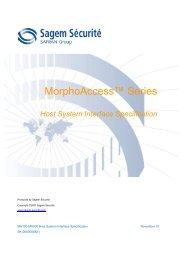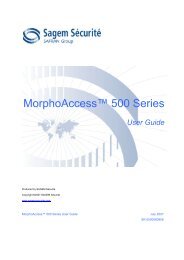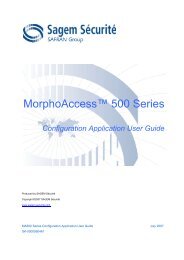MorphoSmartTM Overview
MorphoSmartTM Overview
MorphoSmartTM Overview
You also want an ePaper? Increase the reach of your titles
YUMPU automatically turns print PDFs into web optimized ePapers that Google loves.
MorphoSmart <strong>Overview</strong><br />
4.4 Database<br />
4.4.1 Generalities<br />
Version 1.8 June 2006<br />
Sagem Défense Sécurité Document - Reproduction and disclosure prohibited<br />
SAGEM Défense Sécurité<br />
The MorphoSmart TM manages an internal database that stores templates (minutiae) and user<br />
attributes (for example name, address ...). This database can be filled during an enrollment (live<br />
fingerprint acquisition) or with an already existing compatible biometric database.<br />
A database is a collection of records. Records are a collection of fields.<br />
Each record contains data relative to one enrolled person: his/her minutiae and his/her attributes (for<br />
example name, address ...).<br />
Database records contain the following fields:<br />
− Index Unique internal index number (used only internally for optimization<br />
purposes),<br />
− UserID User unique identifier that can be freely retrieved from the database,<br />
− Template One-or two-finger minutiae template that can not be retrieved,<br />
− Public data Field that can be freely retrieved from the database,<br />
− Private data Field that can only be retrieved upon successful biometric identification.<br />
Records are referenced by their UserID.<br />
All fields (UserID and supplementary fields) are managed as byte arrays. If you need to use string, do<br />
not forget to manage the ending ‘\0’.<br />
One-finger and two-finger templates can be freely mixed in the database.<br />
During database creation the programmer specifies:<br />
− Maximum number of records,<br />
− Maximum number of templates per record,<br />
− Maximum number of fields per record,<br />
− Maximum field size (for each field).<br />
The MorphoSmart TM reserves the necessary flash memory during database creation to guarantee<br />
that those characteristics can be fulfilled any time.<br />
Once created, it is not possible to modify the database internal structure.<br />
Example:<br />
It is possible to store a login name (public data) and its associated password (private data) in the<br />
MorphoSmart TM .<br />
4-13






